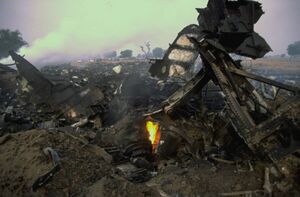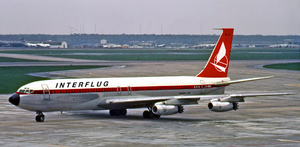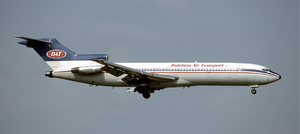Lilienwald air disaster
This article is incomplete because it is pending further input from participants, or it is a work-in-progress by one author. Please comment on this article's talk page to share your input, comments and questions. Note: To contribute to this article, you may need to seek help from the author(s) of this page. |
 Wreckage and parts of the two planes the day after the accident | |
| Mid-air collision | |
|---|---|
| Date | 14 August 1979 |
| Summary | Mid-air collision caused by pilot error and ATC confusion |
| Site | Lilienwald-Sigismundsee, Lilienburg (and Rudolfszell, Mascylla) |
| Total fatalities | 281 |
| Total survivors | 0 |
| First aircraft | |
 IU-GCE, the Interflug aircraft involved, in 1977. | |
| Type | Be-185 |
| Name | Kreuzer Sigismund |
| Operator | Interflug |
| Call sign | Interflug 661 |
| Registration | IU-GCE |
| Flight origin | Lannbrück-Meißhardt International Airport, Lannbrück, |
| Destination | Rakonitz-Krjisnik International Airport, Rakonitz, |
| Occupants | 187 |
| Passengers | 171 |
| Crew | 16 |
| Fatalities | 187 |
| Survivors | 0 |
| Second aircraft | |
 DP-AWU, the DAT aircraft involved, in 1978. | |
| Type | Be-202 |
| Name | Aleksandr Korolyov |
| Operator | DAT |
| Call sign | Dulebian 21 |
| Registration | DP-AWU |
| Flight origin | Ulich Zhdanovo International Airport, Ulich, |
| Destination | Königsreh–Albert Polschnitz Airport, Königsreh, |
| Occupants | 94 |
| Passengers | 89 |
| Crew | 5 |
| Fatalities | 94 |
| Survivors | 0 |
The Lilienwald air disaster was a mid-air collision accident between two passenger planes of Interflug and DAT over Lilienburg at night on 14 August 1979. Interflug Flight 662, a Be-185 en route from Lannbrück, Mascylla, to Rakonitz, Krumlau, and Dulebian Air Transport Flight 21, a Be-202 en route from Ulich, Dulebia, to Königsreh, Mascylla, collided in mid-flight over the borough of Lilienwald-Sigismund in Lilienburg and the border town of Rudolfszell in Mascylla. The crash killed all 281 people on board both aircraft, leaving no survivors and making it the world's deadliest mid-flight collision and the worst aviation accident to occur in Lilienburg.
Official investigation by Lilienburgish authorities identified the confusion of the air traffic control in service of the involved airspace sector about the locations of the planes, as well as mistakes and errors made by the pilotes who tried to avoid the aircraft collision as the main cause of the collision. The accident ultimately led to the universal use of TCAS, an automated on-board collision avoidance system, and better efforts by ATCs to distribute traffic control on more personnel and automated instruments.